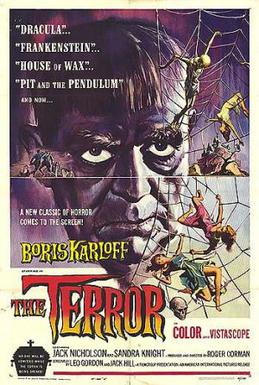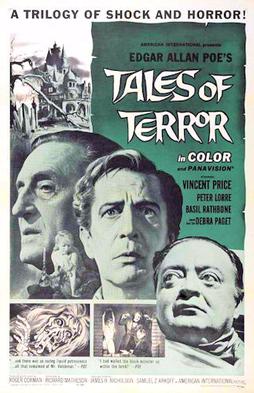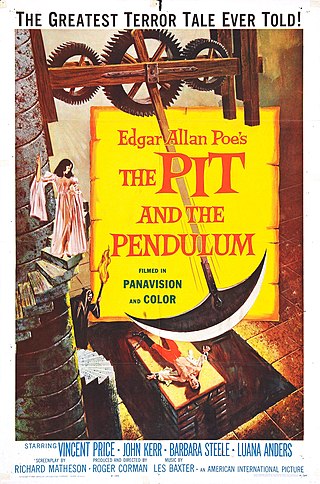Plot
On a mountain in medieval Italy, an old woman meets a red-cloaked figure shuffling Tarot cards. The figure gives her a white rose, which then turns red and dappled with blood.
Prince Prospero, a Satanist, visits the village he rules, and is confronted by two starving villagers, Gino and Ludovico. Meanwhile, the old woman dies, infected with a deadly plague known as the Red Death. Upon discovering her, Prospero orders the village burned and abducts Gino, Ludovico and Francesca, who is Ludovico's daughter and Gino's lover. He then tells the local nobility to come to his castle.
At the castle, Francesca is finely dressed by Prospero's consort, Juliana, and the gathered nobility are entertained by two dwarf dancers, Esmeralda and Hop-Toad. When Esmeralda accidentally knocks over a goblet of wine, one of Prospero's guests, Alfredo, strikes her. Meanwhile, Juliana tells Prospero she wishes to be initiated into his Satanic cult.
Imprisoned in the castle, Gino and Ludovico are taught armed combat so that they can kill one another as entertainment for the nobility, which they refuse to do. Juliana performs a ritual in the Black Room, pledging her soul to Satan, and then gives Francesca the key to Ludovico and Gino's cell. During their escape attempt, Gino, Ludovico and Francesca are recaptured by Prospero.
At a feast, Prospero summons Gino and Ludovico. During his execution, Ludovico attempts to kill Prospero. He fails and dies at Prospero's hands. Prospero then casts Gino out of the castle to be killed by the Red Death. In the Black Room, Juliana undergoes her final initiation ceremony, drinking from a chalice and suffering hallucinations of figures who stab at her as she lies on an altar. Awakening from her dream, Juliana is killed by a falcon. As the nobles gather about her body, Prospero comments that Juliana is now married to Satan.
Outside the castle, the remaining villagers beg Prospero for sanctuary, and he orders them to go away. When they refuse to move, he has them shot down with crossbow bolts, deliberately sparing only one small girl.
Meanwhile, Hop-Toad, enraged by the striking of Esmeralda, persuades Alfredo to wear an ape costume to Prospero's masked ball, where no one is allowed to wear red. In the guise of the ape's trainer, Hop-Toad ties Alfredo to a lowered chandelier and raises him above the assembled guests. He then soaks Alfredo with brandy and fatally sets him on fire before fleeing.
During the ball, Prospero notices the entry of the mysterious, red-cloaked figure. He and Francesca follow the figure into the Black Room, as Prospero believes it to be an ambassador of Satan. He asks to see its face, to no avail. At the ball, all of the nobles die of the Red Death, but their corpses keep dancing. Prospero asks for Francesca to be spared and given the same high status in Hell as he believes he himself will receive. The figure complies, and Francesca sadly kisses Prospero before leaving. The figure turns out to not be a servant of Satan, but the Red Death itself. Prospero rips off its mask to reveal his own blood-spattered face beneath. Horrified, he attempts to flee through the now-infected crowd, to no avail. Cornering Prospero in the Black Room, the Red Death notes that his soul "has been dead for a long time" and kills him.
The Red Death (Anthrax) later plays with the surviving girl, using the Tarot cards. Other similarly cloaked figures gather around the Red Death, each wearing a different colour: white (Tuberculosis), yellow (Yellow Fever), orange (Scurvy), blue (Cholera), violet (Influenza), and black (Bubonic Plague). They discuss among themselves how many people each of them "claimed" that night. When asked of his work, the Red Death notes that only six are left: Francesca, Gino, Hop-Toad, Esmeralda, the little girl, and an old man from a nearby village. The Red Death declares "Sic transit gloria mundi" (Latin for "Thus passes the glory of the world") and the cloaked figures walk into the night. Over the procession are Poe's words: "And darkness and decay and the Red Death held illimitable dominion over all".
Production
Roger Corman later said he always felt "The Masque of the Red Death" and "The Fall of the House of Usher" were the two best Poe stories. After the success of House of Usher (1960), he strongly considered making Masque as the follow-up. [3]
In 1961, Corman announced he would make Masque from a script by Charles Beaumont to be produced for his Filmgroup Company. [4] However, he later said he was reluctant to move forward because it had several elements similar to The Seventh Seal (1957), and Corman was worried people would say he was stealing from Bergman. "I kept moving The Masque of the Red Death back, because of the similarities, but it was really an artificial reason in my mind", he later said. Eventually, he decided to go ahead and do it anyway. [5]
Another factor in the delay was that Corman had a great deal of trouble coming up with a screenplay with which he was happy. Drafts were written by John Carter, Robert Towne and Barboura Morris, but Corman was not happy with any of them. [6]
There were also a number of rival adaptations of Masque being considered around this time. The Woolner Brothers announced a film based on the story [7] as did producer Alex Gordon, who said he had Price as star. [8] [9]
Corman was pleased with an early draft from Beaumont, which introduced the concept of Prince Prospero being a Satanist. Corman felt this draft still needed work, but Beaumont was too ill to come to England for rewriting. So he hired R. Wright Campbell, who had just made The Secret Invasion with Corman, to come with him. Corman says it was Campbell who introduced the subplot of the dwarf, from another Poe story, "Hop-Frog". [5]
Casting
Corman cast Patrick Magee, with whom he had previously worked on The Young Racers (1963). "He could find these strange little quirks which he would bring out during his performance, making it a richer and more fully rounded characterization", recalls Corman. [5]
Filming
AIP had a co-production deal with Anglo-Amalgamated in England, so Sam Arkoff and James H. Nicholson suggested to Corman that the film be made there. This meant the film could qualify for the Eady levy and increase the budget; normally, an AIP film was done in three weeks, but Masque was shot in five weeks. (Although Corman felt that five weeks in England was the equivalent to four weeks in the US because English crews worked slower.) [5] Many of the extensive castle sets were left over from Becket , which had been shot earlier that year and had won a BAFTA award for its sets (as well as a nomination for the Academy Award for Best Art Direction). [10] The film was one of the first films shot in color by cinematographer Nicolas Roeg. [11]
Dan Haller was used as production designer but not credited to ensure the film qualified as British. Corman says this was why George Willoughby was credited as producer, although it was Corman who was the actual producer. [5]
Corman later expressed dissatisfaction with the final "masque" sequence, which he described as "the greatest flaw" in the film, feeling he did not have enough time to shoot it. He filmed it in one day, which he said would have been enough time in Hollywood but that English crews were too slow. [5]
Release
When the film came out, producer Alex Gordon sued AIP, claiming the film was based on a script he had written; however, he lost his case in court. [5]
British censors removed part of a scene where Hazel Court's character asks the devil to send her a demon. The BBC wrongly claimed in a documentary the removed scene was one where she imagines a series of demonic figures attacking her while she lies on a slab.
This was proven when journalist Sandy Robertson, using a letter from producer Samuel Z. Arkoff, finally got the BBFC to release their files on the film. The scene where she's attacked by figures while on a slab was in every print seen in the UK, including one Robertson saw as early as the 1960s. British and UK censors required different cuts, which weren't restored until the 2018 restoration by Martin Scorsese's film foundation.
Corman recalled years later:
From the standpoint of nudity, there was nothing. I think she was nude under a diaphanous gown. She played the consummation with the Devil, but it was essentially on her face; it was a pure acting exercise. Hazel fully clothed, all by herself, purely by acting, incurred the wrath of the censor. It was a different age; they probably felt that was showing too much. Today, you could show that on six o’clock television and nobody would worry. [3]
Reception
Eugene Archer of The New York Times wrote, "The film is vulgar, naive and highly amusing, and it is played with gusto by Mr. Price, Hazel Court and Jane Asher ... On its level, it is astonishingly good." [12] Variety declared, "Corman in his direction sets a pace calculated to divert the teenage taste particularly, and past experience with Poe makes him a worthy delineator of this master of the macabre. In Price is the perfect interpreter, too, of the Poe character, and he succeeds in creating an aura of terror." [13] The Monthly Film Bulletin wrote, "Unquestionably Roger Corman's best film to date, The Masque of the Red Death has passages of such real distinction that one wishes he could be persuaded to take himself more seriously ... Where most films of this nature tend simply to pile on the blood, here there is a genuine chill of intellectual evil, because Vincent Price, initiating horrible tortures with a characteristic air of sadistic glee, also conveys a genuine philosophical curiosity as to the unknown territories into which his quest for evil may lead him." [14]
The film was not as successful as other Poe pictures, which Sam Arkoff attributed to it being "too arty farty" and not scary enough. Corman later said, "I think that is a legitimate statement. The fault may have been mine. I was becoming more interested in the Poe films as expressions of the unconscious mind, rather than as pure horror films." [5] Nonetheless, Corman says the film is one of his favourites. [15] Andrew Johnston, writing in Time Out New York concluded: "Elaborate sets and costumes and Nicolas Roeg's lush technicolor photography make this as close as Corman ever came to real greatness." [16]

















